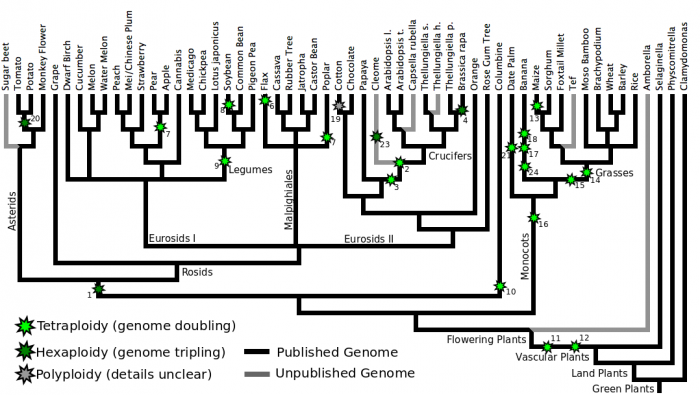Plant paleopolyploidy: Difference between revisions
| Line 31: | Line 31: | ||
===3 Arabidopsis beta=== | ===3 Arabidopsis beta=== | ||
As of yet not a single lineage has been identified in which the beta tetraploidy (naming conventions from Bowers et al 2003<ref name="bowers">) is the most recent whole genome duplication. This duplication is significantly older than arabidopsis alpha, however precise dating is difficult given the acceleration of synonymous substitutions in the arabidopsis lineage. | As of yet not a single lineage has been identified in which the beta tetraploidy (naming conventions from Bowers et al 2003<ref name="bowers" />) is the most recent whole genome duplication. This duplication is significantly older than arabidopsis alpha, however precise dating is difficult given the acceleration of synonymous substitutions in the arabidopsis lineage. | ||
===4 Brassica hexaploidy=== | ===4 Brassica hexaploidy=== | ||
Revision as of 18:51, 9 November 2011
The plant lineage, and specifically angiosperms, have a genomic history of repeated whole genome duplication events. This pattern of changing their ploidy level (or number of copies of their genome) is something that happens frequently today, and many domesticated crop plants have been selected with various ploidy levels. While the mechanisms are unknown that permit polyploidy is some lineages such as plants, and not as frequently in others such as mammals [1].
Identifying and characterizing plant paleopolyploidies is ongoing research. They are identified through whole genome comparisons using a combination of the data derived from genomic structure (e.g. syntenic dotplots) and evolutionary distances (e.g. synonymous mutation rates). As such, detecting these events and determining which lineages share what subset are continually changing. The images presented here represent our views right now, but are subject to change. Events that were previously undetected or missed can suddenly be seen with an improved build of a genome or the the sequencing of a fortuitously placed outgroup.
As new genomes become available, and previous genomes are updated, we will continue to improve these figures.
Plant Phylogenetic Tree With WGD Marked

Discussion of individual tetraploidies
1 Eudicot Hexaploidy
Synonyms: Arabidopsis Gamma
This hexaploidy (genome tripling) is shared by the core eudicots (the rosids and asterids), and may be present in additional, basal eudicots, although it will not be possible to reach this conclusion until the genomes of species from basal lineages are sequences -- AND WELL ASSEMBLED!
This whole genome duplication was first identified as the most ancient of three whole genome duplication present in the genome of Arabidopsis thaliana, and assigned the name "gamma" by in 2003 by Bowers et al. [2]:
In this paper, hampered by the fact that only two plant genomes had yet been sequenced, and the ridiculously accelerated rate of base pair substitution in arabidopsis the authors concluded the gamma event was likely shared by both monocots and eudicots and could potentially be as old as the split between gymnosperms and flowering plants 300 million years ago.
With the publication of the grape genome in 2007[3] which has not experienced any duplications since the eudicot hexaploidy and doesn't show the same acceleration of nucleotide substitutions, it became possible to conclude that the eudicot hexaploidy was NOT shared with monocots and was shared by all rosids.
More recent work in the asterids[4] indicate that this highly successful eudicot clade share the same ancient whole genome duplication.
2 Arabidopsis alpha
The alpha tetraploidy of arabidopsis was first given that name in Bowers et al 2003[2]. It is shared by most or all of the crucifers (family Brassicaceae).
3 Arabidopsis beta
As of yet not a single lineage has been identified in which the beta tetraploidy (naming conventions from Bowers et al 2003[2]) is the most recent whole genome duplication. This duplication is significantly older than arabidopsis alpha, however precise dating is difficult given the acceleration of synonymous substitutions in the arabidopsis lineage.
4 Brassica hexaploidy
5 Poplar tetraploidy
6 Cucumber tetraploidy
7 Apple tetraploidy
8 Soybean tetraploidy
9 Legume tetraploidy
10 Columbine tetraploidy
11 Flowering plant tetraploidy
12 Seed Plant Tetraploidy
13 Maize Tetraploidy
14 Grass Tetraploidy
15 Monocot Tetraploidy A
16 Monocot Tetraploidy B
- ↑ There is a case of a tetraploid rodent: Gallardo. 2006. Molecular cytogenetics and allotetraploidy in the red vizcacha rat, Tympanoctomys barrerae (Rodentia, Octodontidae) Genomics. 88:2, 214-221. doi:10.1016/j.ygeno.2006.02.010
- ↑ 2.0 2.1 2.2 Bowers JE et al (2003) "Unravelling angiosperm genome evolution by phylogenetic analysis of chromosomal duplication events." Nature DOI: 10.1038/nature01521
- ↑ Jaillon O et al (2007) "The grapevine genome sequence suggests ancestral hexaploidization in major angiosperm phyla." Nature DOI: 10.1038/nature06148
- ↑ Cenci A et al (2010) "Comparative sequence analyses indicate that Coffea (Asterids) and Vitis (Rosids) derive from the same paleo-hexaploid ancestral genome." Molecular Genetics and Genomics DOI: 10.1007/s00438-010-0534-7